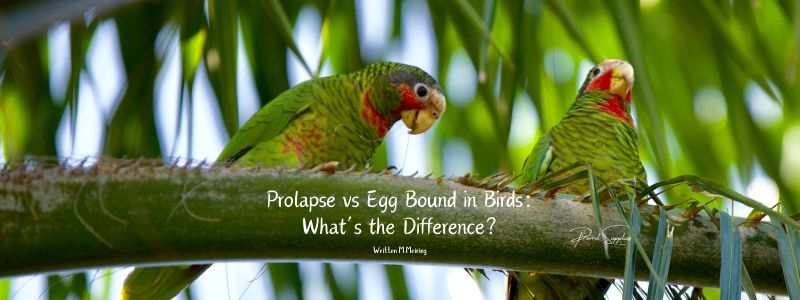Prolapse vs Egg Bound in Birds: What’s the Difference?
When you hear about a bird having “reproductive trouble,” it can sometimes involve egg-binding or prolapse (or even both). Though related to the reproductive tract, these are distinct conditions—and knowing the difference can help catch problems early and get proper treatment.
Here’s a breakdown, in plain language.
What is Egg‑Binding?
Egg-binding (also called dystocia or oviposition failure) happens when a bird is unable to pass (lay) a fully or partially formed egg through the oviduct and out the cloaca.
-
The egg may be stuck somewhere in the oviduct (shell gland, uterus, vagina) or at the cloacal entrance. Rangiora Vet Centre+2Merck Veterinary Manual+2
-
Birds under strain, with nutritional deficiencies (especially low calcium), obesity, infection, or poor muscle function are more susceptible. jwpr.science-line.com+3DVM360+3Rangiora Vet Centre+3
-
Symptoms might include straining, fluffed appearance, lethargy, swollen abdomen, tail wagging, difficulty breathing, or even cloacal prolapse secondary to the pressure. DVM360+2Rangiora Vet Centre+2
Because egg-binding is a medical emergency, swift intervention is necessary. AVMA Journals+2Merck Veterinary Manual+2
In many cases, treatment may begin with stabilization: fluids, warmth, calcium support, and careful manipulation or medicines to induce contractions. DVM360+2AVMA Journals+2 If that fails, more invasive techniques like aspiration or surgery may be required. jwpr.science-line.com+4AVMA Journals+4ResearchGate+4
A recent study in JAVMA notes that many cases of egg binding in pet birds can be resolved if treated promptly. AVMA Journals
What is Prolapse?
Prolapse (or cloacal / vent / oviduct prolapse) is when internal tissues (such as the cloaca lining, oviduct, uterus) are pushed or turned outward through the vent opening.
-
In a vent (cloacal) prolapse, the lining or deeper tissues of the cloaca protrude outside the vent. ResearchGate+2Merck Veterinary Manual+2
-
In oviduct or uterine prolapse, part of the oviduct or uterus may invert and protrude. ResearchGate+2DVM360+2
-
The prolapsed tissues are exposed to the environment, which puts them at risk of trauma, infection, drying out, and tissue death (necrosis).
-
Prolapse may occur independently (due to strain, weakness, infection, trauma) or as a complication of egg-binding or dystocia. In other words, a stuck egg might push tissue outwards. DVM360+2ResearchGate+2
In one case study of chickens, a bird had a combination: the uterus and cloaca prolapsed, and eggs were lodged in the uterus. ResearchGate
Clinically, prolapse is obvious: you often see tissue hanging out of the vent. The area may be swollen, reddened, raw, or damaged.
Prompt treatment is critical: the tissues must be kept moist, cleaned, reduced (pushed back carefully), and sometimes sutured (a “purse-string” suture around the vent) to prevent recurrence. ResearchGate+2Merck Veterinary Manual+2
Key Differences at a Glance
| Feature | Egg Binding | Prolapse |
|---|---|---|
| Definition | Failure to lay (expel) an egg that is stuck in the reproductive tract | Internal tissues (cloaca lining, oviduct, uterus) protrude through the vent |
| Location | Inside oviduct, shell gland, uterus, or cloaca | Vent opening, with visible tissue outside |
| Primary issue | Mechanical obstruction, weak muscles, egg too large, nutritional / metabolic causes | Trauma, straining, infection, weakness, or downstream pressure pushing tissue outward |
| Signs / symptoms | Straining, swollen abdomen, fluffed-up, lethargy, respiratory distress, tail wagging | Visible protruding tissue, swelling, redness, possible bleeding |
| Complication relation | Egg binding can lead to prolapse if unchecked | Prolapse may occur with or without egg-binding, but often as a complication |
| Urgency / risks | High — can lead to internal damage, toxicity, death | Very high — risk of necrosis, infection, tissue damage |
| Treatment | Stabilize, calcium, lubrication, possibly surgery or aspiration | Keep tissue moist, clean, reduce tissue, sutures, antibiotics, supportive care |
Why It Matters & What Bird Owners Can Do
-
Because bird anatomy is delicate, delays in diagnosis or treatment lead to serious complications (infection, tissue death, infertility, or death).
-
Preventive care is essential: proper nutrition (especially calcium, vitamins), balanced diets, stress reduction, exercise, clean environment, and monitoring laying behavior.
-
Be alert to early signs: straining, swollen belly, reduced appetite, lethargy, or seeing tissue at the vent.
-
Always consult an avian veterinarian. Do not try aggressive manipulation unless you’re trained; you could worsen damage.
Case Examples & Research Insights
-
In two silky hens, one had a uterine/cloacal prolapse with egg lodgement, and the other was egg-bound. Treatment involved flushing, surgery, and sutures. (Joy & Divya, 2014) ResearchGate
-
A study of commercial layers in India found that egg-bound syndrome affected around 2.74% of carcasses examined, with major contributing factors including heat stress, hypocalcemia, large egg size, obesity, and salpingitis (oviduct infection). jwpr.science-line.com
-
In pet bird care literature, egg‑binding is discussed as a frequent emergency; authors emphasize early supportive care, calcium therapy, lubrication, and possible use of drugs or surgery depending on severity. DVM360+2Merck Veterinary Manual+2
Final Thoughts
Although egg-binding and prolapse are different conditions, they're related in that trouble in the reproductive tract can lead to either—or both. As a bird caregiver or store operator, you can:
-
Educate customers to watch for warning signs.
-
Promote good nutrition, supplements, and preventive measures (e.g. calcium, balanced diets, safe environment).
-
Remind them that time is of the essence—veterinary help should be sought immediately.

